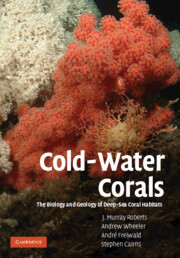Preface
Published online by Cambridge University Press: 23 December 2009
Summary
Corals are not restricted to shallow-water tropical seas. Of the approximately 5100 coral species alive today over half are found in deep waters. Cold-water corals can be found over a tremendous range of latitudes from tropical to polar regions and from the shallows to the deep sea. We have known about cold-water corals since the mid-eighteenth century, and pioneering oceanographic expeditions in the late nineteenth century frequently recovered cold-water corals in their dredge nets. But only since the 1970s, and particularly in the last ten years, as acoustic survey techniques have improved and been applied to wider areas of the continental shelf, slope, offshore banks and seamounts have we begun to reveal the true extent of cold-water habitats around the world. In this book we try to summarise what we know about cold-water corals and capture the excitement of a field that is now growing exponentially. For instance, a literature search for the terms ‘cold-water coral’ and ‘deep-sea coral’ over the 20 years up to 1996 returned less than 300 publications whereas the same search terms for the following 10 years revealed nearly 700 (see Fig. 1).
The scientific community's fascination with cold-water corals has developed for several reasons. As sessile, suspension feeders that produce complex, sometimes long-lasting, three-dimensional structural habitat they fall at a natural confluence of biology, hydrography and geology. A few species of scleractinian cold-water corals develop elaborate reef frameworks that have spawned many studies into the processes underlying cold-water coral reef and coral carbonate mound formation.
- Type
- Chapter
- Information
- Cold-Water CoralsThe Biology and Geology of Deep-Sea Coral Habitats, pp. xi - xiiiPublisher: Cambridge University PressPrint publication year: 2009

